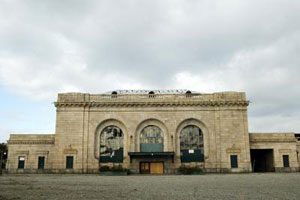Shuttered but not forgotten: 16th Street depot ready for rebirth
Shuttered rail station is worse for wear, but wheels are turning on effort to create community beacon serving West Oakland
OAKLAND TRIBUNE
by by Cecily Burt
December 28, 2008
WEST OAKLAND — It’s been years since Rick Holliday bought the stately Beaux Arts train depot on Wood Street and spearheaded the future development of several dusty acres surrounding it.
Although the first of hundreds of new lofts and townhomes are popping up nearby, the prized centerpiece of the massive Wood Street residential development is in bad shape.
Squatters and graffiti artists have been unkind, and a tour last week revealed more damage to the landmark station inside and out. The second-story rail platform had hosted a paint ball war, with the splattered evidence left behind on the walls and iridescent azure paint beads littering the crumbling stairs.
But things are starting to move the station’s way. A nonprofit board has been formed to oversee the station’s resurrection as a place to honor and learn about West Oakland’s history, a place where young people gain useful job skills, and space for community gatherings.
RAILS, short for Restoration Association for Improving the Landmark 16th Street Station, is composed of three representatives from the Train Station Partnership organization, two representatives from BUILD, the development company that owns the station, and a sixth representative jointly chosen by the other five board members. Members of the Train Station Partnership had come together to preserve the station’s baggage wing and win other concessions from the developers such as the inclusion of affordable units and the promise of local hiring.
The nonprofit also will eventually own and operate the station complex, which will be named the C.L. Dellums Center for Community Sustainability.
A long way to go
Early estimates conservatively peg the project at $58 million. That includes more than $7 million to buy the station from BUILD, including the baggage wing and rail platform, and a separate vacant parcel of land for a new office building to house community organizations and nonprofits associated with the station. Restoration and development costs are included in the $58 million estimate.
Much of that money will come from tax increment funds generated by the construction and sale of the large residential Wood Street redevelopment project surrounding the station. Due to delays in starting construction on many of the units, however, the estimated tax increment revenue available for reinvestment in West Oakland has declined from $251 million to $75 million, according to Conley Consulting Group.
The station was closed after it was damaged during the 1989 Loma Prieta earthquake, and everyone is concerned about another large temblor striking before the building is retrofitted. And the place has been a constant target for graffiti artists, vandals and squatters, who set a fire inside some months ago.
“We want to make sure that the building gets protected in case there is another earthquake, so there definitely is a sense of urgency,” said Greg Hodge, RAILS board member appointed by the Train Station Partnership.
“That’s something we will look at, “… are there interim things we can do to protect the building,” added Margaretta Lin, director of community economic justice for the East Bay Community Law Center and a train station partner.
The Oakland City Council this fall agreed to spend $400,000 in redevelopment funds to pay for a six-month feasibility study and other predevelopment costs.
Rotunda and Fox Theatre developer Phil Tagami has been hired to prepare the study, which will include a structural analysis and recommendations, schematic plans, architectural analysis, surveys, environmental evaluations, traffic studies and options for historic preservation. Most of the funds will be used to hire consultants.
Tagami has been working cooperatively with the Train Station Partnership, building on extensive work by the community to define the guiding principles for reuse of the station complex, which includes the main hall, baggage wing, signal station, plaza, rail platform and a proposed new building that will house local businesses and nonprofits.
Honoring West Oakland
The overall goal is to restore the station and make it financially sustainable, while also honoring West Oakland’s cultural and historic legacy.
So far it seems clear that the station — most likely the baggage wing — will include exhibit space honoring the Pullman Porters, the Brotherhood of Sleeping Car Porters labor union, whose West Coast headquarters were located in West Oakland, and the role the station played in the migration of Europeans and, later, African-American families to West Oakland.
Oakland Mayor Ron Dellums grew up a block away in a duplex on Wood Street, and he has taken a personal interest in the project from the outset, stepping in to urge opposing forces — and there were many — to work together toward a common goal.
“This was always a place of great fascination to me,” he said. “People coming from different places, trains going to different places.”
Dellums said he and gang of young friends would run onto the rail cars — they called them the ‘cookie cars’ — after the passengers had disembarked, scooping up any left over candy, cookies, magazines, or, best yet, comic books. His uncle, C.L. Dellums, was the West Coast vice president of the Pullman Porters labor union, and his father was a sleeping-car porter for a short time.
“They were like the astronauts of the 1940s,” he recalled. “They would come back with such stories.”
Using the space
The grand main hall and other areas of the station would serve as event space for meetings, parties and other community events, and local merchants could operate kiosks in the station plaza, alongside a train car cafe. Another rail car would be dedicated to youths to host their own cultural events.
The station and adjacent complex would be used as office space for business incubators and nonprofit community programs offering green job training, youth development and cultural arts. A commercial kitchen could be used to cater events and further the culinary training program at McClymonds High School.
Lin is amazed at how far the project has come since those early fights over the baggage wing and affordable housing.
“It was the train station (itself) that brought the community folks together with the developers,” Lin said. “We all realized we had a common interest in the restoration of the train station, and the difficulty of doing that required us to all work together and role up our sleeves. It will be an incredibly challenging project, but the payoff will be great.”



